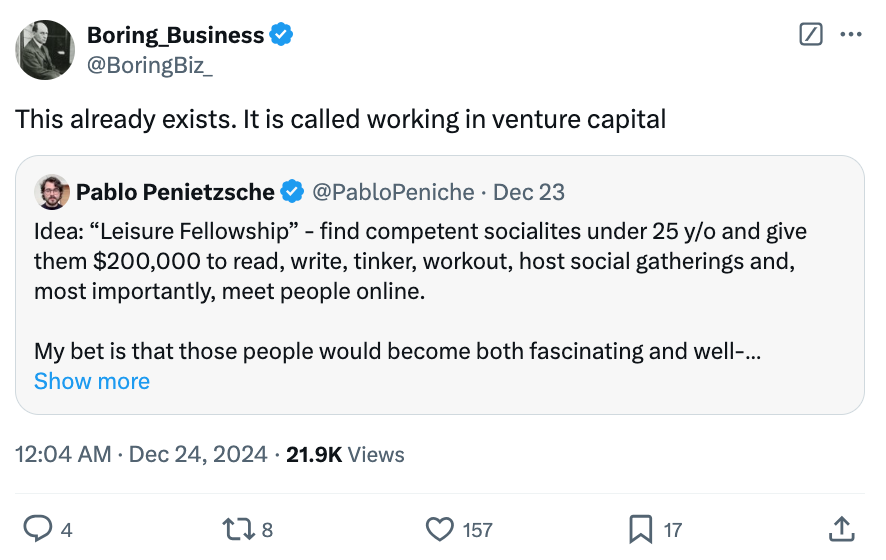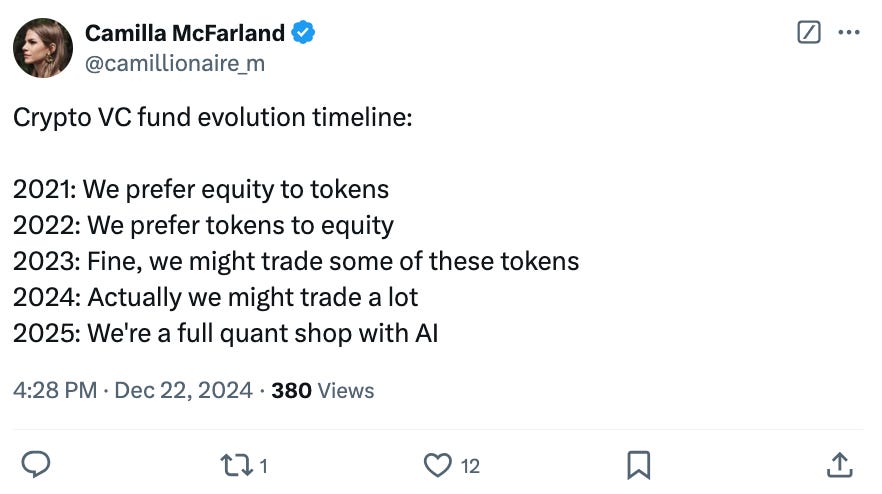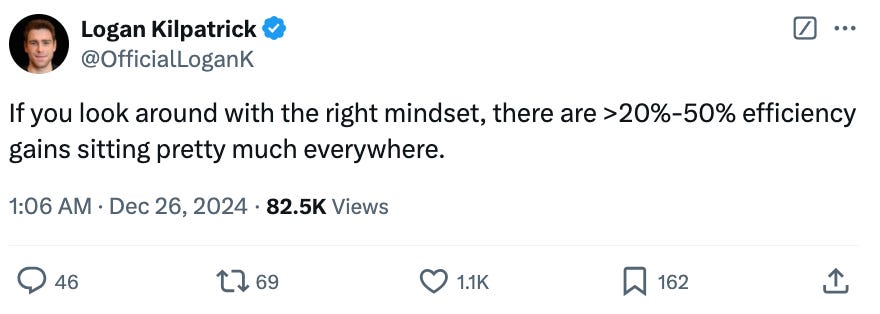Moneyball is a newsletter from Koble exploring the limitations of human decision-making and their implications for startup investing.
We’ve spent four years developing our groundbreaking algorithms, which discover early-stage startups that outperform the market and predict their probability of success.
This week
🧠 Mental Model #38 – On The Objective Paradox – The Dangers of Planning
📖 Investor reading – Big bets on AI point to VC industry’s shift – Venture Capital Partners are leaving big firms in droves – What we learned about AI from active startup investors this year
💬 Some tweets – It’s called working in Venture Capital – Crypto VC fund evolution timeline – 20-50% efficiency gains pretty much everywhere
The Dangers of Planning
Planning is synonymous with the process of founding and scaling startups. Having a plan is a given; without one, founders are simply uninvestable.
This conventional wisdom is deeply misguided. And by swallowing it without question, founders and investors are missing out on massive opportunities to create new products, business models, and vehicles for wealth creation.
Kenneth O. Stanley and Joel Lehman’s 2015 book, “Why Greatness Cannot Be Planned: The Myth of the Objective” is pretty obscure. It shouldn’t be. Because it highlights something completely counterintuitive and heretical to the status quo thinking about startups:
“The Objective Paradox”.
Overemphasis on objectives can actually hinder innovation because it narrows the focus too much, missing out on indirect routes or stepping stones that could lead to greater achievements.
The most popular feature of your product might not be what you initially planned as the main attraction; solving your own problems can lead to game-changing user insights; a side project can become a company.
Startups that rigidly adhere to a pre-ordained plan risk missing out on serendipitous opportunities. Or they fail to pivot when necessary, and so die without having explored their full potential.
The modern obsession with objectives and clear, measurable goals (exemplified by the ubiquitous “OKR”) might not be the best path to meaningful breakthroughs. This is because the future of technology, and the market’s needs are unpredictable. Founders who fixate on crystal clear goals all too often get lost in the fog or war.
Stanley and Lehman advocate for a more flexible and responsive method, which they call the “Stepping Stone Approach”.
Instead of fixating on a distant goal, startups should focus on the immediate next steps. This approach allows for adaptability, learning, and sometimes, accidental discoveries that can lead to major innovations. They describe a “Treasure Hunter” mindset, whereby the focus is on collecting interesting, valuable insights one at a time.
The greatest founders know that innovation often comes from exploring the “interesting” rather than the “correct”. But try telling that to the average VC!
This approach doesn’t advocate for chaos but rather for a dynamic, responsive strategy that can lead to unforeseen greatness.
The parallels to AI research and development are clear. Stanley’s concept of “Novelty Search”, where algorithms are designed to seek out the novel rather than the optimal, mirrors the startup journey. AI systems that explore without a fixed objective often stumble upon innovative solutions that a strictly goal-oriented approach might bypass.
We’re really talking about the difference between exploration and exploitation. Algorithms can either exploit known paths to optimise for a specific goal, or explore new territories to find potentially better solutions. The latter is where the most exciting and significant work is taking place.
Stanley’s work encourages embracing the uncertainty and complexity of AI development, suggesting that the richest outcomes might come from allowing AI systems to evolve in ways that are not strictly controlled by human-defined objectives.
Examples of this phenomenon playing out in the startup world are plentiful:
YouTube began life not as a video-sharing platform but as a dating site called “Tune In Hook Up”, where users could upload videos to attract potential dates. The dating aspect didn’t take off, but the founders noticed people were more interested in sharing all sorts of videos.
Instagram was originally a part of a project called Burbn, which was intended to be a comprehensive check-in app with elements like gaming and photo sharing. However, the founders realised that the photo-sharing aspect was what users engaged with most.
Slack began as an internal communication tool for a gaming company, Tiny Speck, which was developing an online game called Glitch. When Glitch didn’t succeed, the company was on the brink of closure, but the team realised that their internal tool for communication had significant potential.
Twitter was born out of a side project at Odeo, a podcasting platform. During a company hackathon, the concept of a microblogging platform where users could share short updates was developed. Initially called “twttr”, it didn’t attract much attention, but the founders saw potential in the simplicity and immediacy of the communication style.
Groupon started as a platform called The Point, which was designed to bring people together for collective action. One of its uses was for group buying, which caught on much more than the broader platform. Recognising this, the founders pivoted to focus solely on daily deals.
Implications for investors
Stanley and Lehman’s work on “tyranny of objectives” is an important touchpoint for investors. It reminds us that the greatest investments might not come from meticulously planned paths, but rather a journey filled with curiosity, exploration, and the willingness to deviate from predetermined objectives.
For founders, this might mean less time spent on crafting the perfect business plan and pitch deck, and more time engaging with the real world; listening to the market, being ready to pivot when necessary, or explore new avenues when the opportunity arises.
For investors, it means looking at failure differently. Just as AI models learn by trial and error, startups and their founders might fail in one area only to discover a new, viable path. VCs should drop the “we predict the future” mantra and adopt a “Novelty Search” mindset; one that places greater trust in founders and their ability to actively shape the future through new products and business models.
Work with Koble
At Koble, we’ve spent four years developing our groundbreaking algorithms, which discover early-stage startups that outperform the market and predict their probability of success.
We’re working with forward-thinking angels, VCs, family offices, and hedge funds to re-engineer startup investing with AI. If that resonates, get in touch.
Investor reading
💰 Big bets on AI point to VC industry’s shift – The strategy of focusing money on larger deals comes at time of extreme indigestion for start-up investors
🏃♂️ Venture Capital partners are leaving big firms in droves – Mired in an industry downturn, investors are stepping back from jobs to start new firms – or getting pushed out
💡 What we learned about AI from active startup investors this year – Crunchbase speaks with a half-dozen earliest and latest-stage investors this year to understand where they are placing their bets when it comes to AI
Some tweets
Parting shot
“Life can only be understood backwards, but it must be lived forwards.”
― Sören Kierkegaard
Regards from your [unplanned] startup investing AI,
About Koble
Koble is re-engineering startup investing with AI, applying quantitative strategies that have disrupted public markets to early-stage startup investing.







